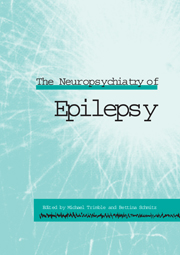Book contents
- Frontmatter
- Contents
- List of contributors
- Part I Background
- Part II Clinical aspects
- Part III Cognitive aspects
- Part IV Nonepileptic attacks
- 13 Epilepsy, dissociation and nonepileptic seizures
- 14 Psychobiology of psychogenic pseudoseizures
- 15 Epilepsy and panic disorder
- Part V Treatment complications
- Part VI Treatment
- Index
13 - Epilepsy, dissociation and nonepileptic seizures
Published online by Cambridge University Press: 05 October 2010
- Frontmatter
- Contents
- List of contributors
- Part I Background
- Part II Clinical aspects
- Part III Cognitive aspects
- Part IV Nonepileptic attacks
- 13 Epilepsy, dissociation and nonepileptic seizures
- 14 Psychobiology of psychogenic pseudoseizures
- 15 Epilepsy and panic disorder
- Part V Treatment complications
- Part VI Treatment
- Index
Summary
Introduction
Within the context of psychiatry and neurology, the term dissociation is extremely difficult to define satisfactorily. Since its introduction in the late nineteenth century, the term has been applied to a wide range of neurological, psychiatric and psychological phenomena. As a result, there is considerable confusion over what actually constitutes dissociation and the concept is frequently misapplied. This is particularly true within the field of epilepsy. Many epileptic phenomena have been labelled as dissociative, including the sensory, affective and cognitive features of partial seizures, behavioural automatisms, postictal amnesia and fugue (Thomas and Trimble, 1997). Similarly, certain psychiatric phenomena that mimic epileptic events, so-called ‘ non-epileptic seizures’, have been identified as primarily dissociative in nature. Indeed, many authorities have argued that the dissociative nature of nonepileptic seizures could provide the basis for their conceptual and practical differentiation from ‘genuine’ epileptic events (Kuyk et al., 1999). If, however, dissociation is experienced both by individuals with epilepsy and by those with pseudo-epileptic seizures, how can its occurrence aid in the differential diagnosis of these conditions?
In this chapter, I will explore what we mean by dissociation and how it relates to the phenomena of epilepsy and nonepileptic seizures. In this way, I aim to demonstrate that (i) many epileptic phenomena previously labelled as dissociative should not be regarded as dissociative at all; (ii) dissociation is a fundamental aspect of nonepileptic seizures;.
- Type
- Chapter
- Information
- The Neuropsychiatry of Epilepsy , pp. 189 - 209Publisher: Cambridge University PressPrint publication year: 2002
- 3
- Cited by



